“Rapture”
Written by L.J. Strom and Hans Beimler
Directed by Jonathan West
Season 5, Episode 10
Production episode 40510-508
Original air date: December 30, 1996
Stardate: unknown
Station log: The Cardassians have returned an icon to Bajor that is the only rendering of the lost city of B’Hala. Sisko has used his influence as the Emissary to have it stop by DS9 on its way to the museum in Ilvia. He has it scanned also—at which point Kira remembers a prophecy stating that only someone touched by the Prophets could find B’Hala. “But no pressure,” Dax adds with amusement.
There’s a spire in the center of the city, as there are in all ancient Bajoran cities, which indicates the coordinates of the city in the cosmos. But the icon only shows one side of the spire, not the other two. However, Sisko discovers that another side of the spire is reflected in another building. He re-creates the spire in a holosuite, now with two sides visible (though the resolution on the reflected side is poor). He’s up half the night, but when he goes to remove the isolinear rod containing the images from the console, he gets a massive shock.
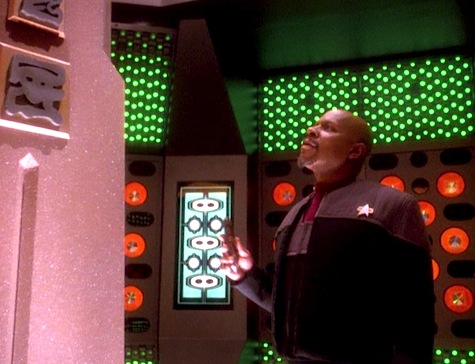
Odo arrests Quark for negligence for not maintaining the holosuites, while Bashir puts Sisko on restricted duty. The captain’s seeing shapes and colors more clearly—part of post-neural shock.
Jake makes dinner for Sisko, and talks about Yates’s imminent return to the station following her prison sentence. But Sisko is distracted by something—he cuts up the melon slices they’re having for dessert to make shapes that he thinks are the images on the still-blank side of the spire.
His work on the spire in the holosuite is interrupted by a call from Admiral Whatley with news: Bajor’s petition to join the Federation has been approved. There’s a celebration in Quark’s. Kira is actually happy about Federation membership, which she wasn’t five years ago, and she wants to congratulate Sisko. He’s still on the holosuite (Quark assures her that he fixed it), and she interrupts a vision he has of B’Hala, of being there for the Peldor festival. Kira realizes he was having a pagh’tem’far, a sacred vision. He continues to obsess over the spire, fobbing off greeting Kai Winn on Kira. (When asked for an excuse, Sisko says, “Just make something up.”)
Just as Sisko has a breakthrough as to B’Hala’s location, Yates arrives. After some smoochie time, he asks her to join him on a trip to Bajor to find it. She goes along—though she worries about his headaches—and sure enough, they find the lost city.
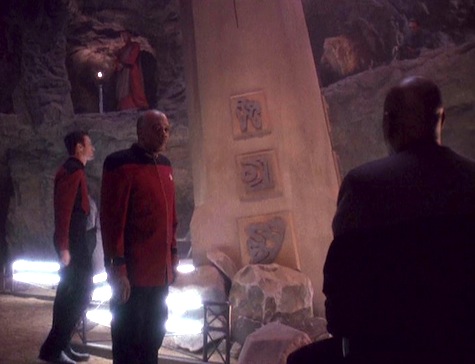
Kira is overwhelmed—Bajoran archaeologists have been looking for B’Hala for 10,000 years, and Sisko found it in a few days—and Winn is just as overwhelmed. The kai admits to Kira that she didn’t really believe that Sisko was the Emissary until he found B’Hala.
Whatley arrives at the station, and then has to schlep to Bajor because Sisko is too busy fangoobering over B’Hala to return his calls. Whatley is concerned about his talk of visions and moments of clarity, and orders him to report to Bashir the next morning for a full physical. There’s still a lot of work to do. The next day, before Sisko arrives, Whatley expresses concern, which only deepens when Sisko starts sharing prophetic wisdom with people on the Promenade—including Whatley.
However, Bashir’s examination reveals that his neural sheaths are depolarizing. Bashir can fix it—if he doesn’t, Sisko will probably die; but if he doesn’t, Sisko will continue to get the visions he’s been receiving, and the captain needs to see it through.
Sisko tells Jake and Yates, who are less than understanding. They think he should undergo the procedure, but Sisko insists that these visions are important—Yates is appalled that he thinks they’re more important than seeing his son grow up. Sisko then goes off with Winn, who has offered guidance, but not before telling Yates and Jake that he loves them both.
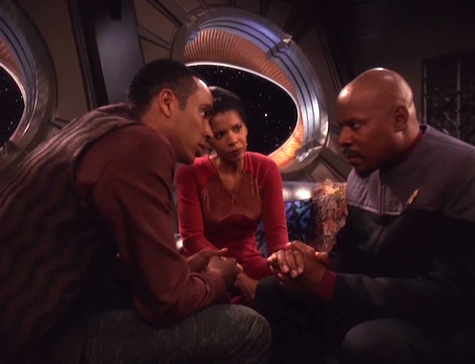
Most of the Bajorans on the station are in the temple praying for the Emissary. Dax and O’Brien are concerned—O’Brien says he’d rather Bashir take care of him than the Prophets—but Kira and Worf are sure that Sisko’s faith will see him through. With Winn’s help, Sisko exposes himself to the Orb of Prophecy.
Just as the signing ceremony is about to start, Sisko bursts into the wardroom saying it’s too soon. If Bajor joins the Federation, it’ll be destroyed.
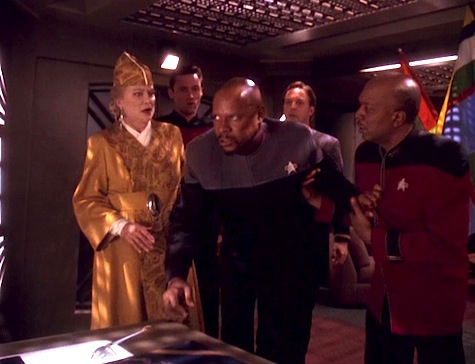
Then he collapses onto the deck, having a seizure. Whatley insists that Bashir perform the procedure that will save his life, but Kira insists that he didn’t want that. Bashir quietly says that it’s not up to any of them—the only person who can override Sisko’s wishes (now that he’s unconscious) is his closest living relative. Jake looks like he’s going to throw up, but he can’t bear to live without his father. He authorizes the procedure.
Winn tells Kira that Bajor won’t join the Federation today. She also says that the Federation shouldn’t have interfered, but Kira points out that it wasn’t the Federation, it was an eighteen-year-old boy who didn’t want to lose his father.
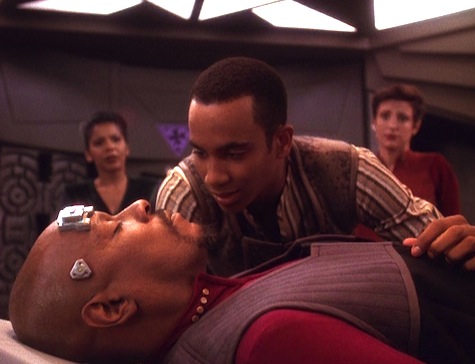
Whatley isn’t happy, but he can’t remove Sisko from this post without risking alienating Bajor more. Sisko also is sure that Bajor will some day join the Federation, so Whatley says he’ll keep the champagne on ice.
Sisko returns to his quarters to discover that Jake has made jambalaya for Yates’s (belated) welcome-home dinner. Yates reminds him that he may have lost something important, but he’s held onto something more important.
The Sisko is of Bajor: Sisko goes full Emissary in this one, experiencing visions, finding the lost city of B’Hala, making predictions, and coming incredibly close to finding out the meaning of life, the universe, and everything. Sadly, Bashir’s operation happened before he could discover that it was “42.”
Don’t ask my opinion next time: Kira has done a full 180 on the Federation since “Emissary”—though that process started in that very episode when she admitted to O’Brien that it would be easier to manage the wormhole with Federation support.
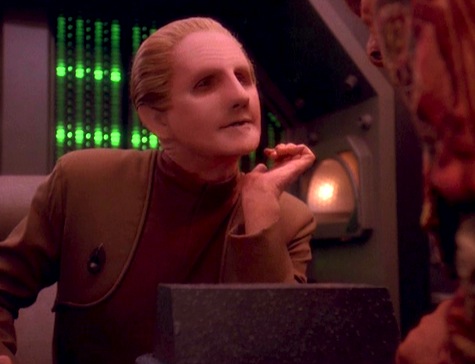
Preservation of mass and energy is for wimps: Odo is frustrated by the politics of assigning quarters to high-ranking Starfleet personnel, as apparently size does matter. When Worf points out that a starship captain should have equivalent billeting to an admiral because it’s “naval tradition,” Odo snidely retorts, “so is keelhauling.”
There is no honor in being pummeled: While Worf does not believe in the Prophets, he does accept that Bajorans believe in them. At one point he tells Kira that Bajor’s gods have given Sisko a powerful vision—something Worf himself has experienced, as seen in “Birthright, Part I” and “Rightful Heir.” At another point, Worf reminds Quark of the old Klingon proverb, “you cannot loosen a man’s tongue with root beer.”
Rules of Acquisition: Quark gleefully unfurls a banner to celebrate the impending joining of the Federation by Bajor—unfortunately, he sets up the wrong banner, and unfurls “Welcome, Klingons!” to Dax’s amusement. Obviously, Quark is ready for anything…
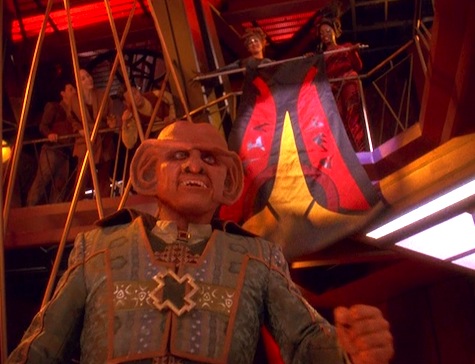
For Cardassia!: Sisko sees a plague of locusts hovering over a reconstructed B’Hala—they blot out the sky and then move on to Cardassia. (It’s a prophetic vision of what happens in “In Purgatory’s Shadow” and “By Inferno’s Light.”)
What happens on the holosuite stays on the holosuite: Quark points out to Sisko that he has a wide assortment of pleasure mazes, and they all have a surprise at the end. Wah-HEY! In any case, we do get to see the holosuite used for research purposes, as Sisko is more readily able to study the icon there.
No sex, please, we’re Starfleet: Sisko is very happy to see Yates, and even kept her old quarters intact for her. “I have some pull with the station CO,” he deadpans.
Keep your ears open: “Do not attempt to convince them, Major. They cannot understand.”
“Since when did you believe in the Prophets?”
“What I believe in is faith. Without it, there can be no victory. If the captain’s faith is strong, he will prevail.”
“That’s not much to bet his life on.”
“You’re wrong. It’s everything.”
Worf, Dax, and Kira on Sisko’s plight.
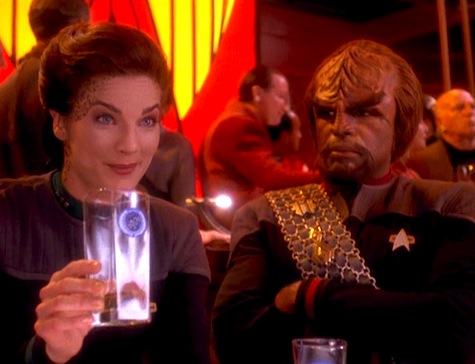
Welcome aboard: Penny Johnson is back as Yates, while Louise Fletcher returns as Winn. Ernest Perry Jr. is depressingly wooden as Whatley.
Trivial matters: This episode establishes a bit of a timeline problem. In “For the Cause,” Yates was sentenced to six months in prison. In “Broken Link,” a later episode, Garak was sentenced to six months in prison. Yet Garak was apparently back working in his tailor shop in “Looking for par’Mach in All the Wrong Places,” and was seen in “Things Past” travelling to Bajor, yet Yates wasn’t released until shortly before this episode.
The crew is now wearing the uniforms that debuted earlier in the month in the movie Star Trek: First Contact. “In Purgatory’s Shadow” will reveal that Bashir has, by this time, been kidnapped by the Dominion and replaced with a changeling (as Bashir will be found in that episode in a Dominion prison camp wearing the old uniform), which means that a changeling performed all of Bashir’s (many) duties in this episode, including major surgery on Sisko’s brain.

It is assumed that the Borg attack in First Contact happened in the time between “The Ascent” and this episode. The events of your humble rewatcher’s eBook Enterprises of Great Pitch and Moment help set the movie up, and also takes place shortly after “The Ascent” (as Nog has returned to DS9 as a cadet in the story).
B’Hala will next be seen in “The Reckoning.”
Sisko actually both fulfills and sabotages his mission on the station as given to him by Picard back in “Emissary.” Picard ordered him to get Bajor into the Federation, and he did—then kills it.
Sisko’s vision of locusts flying toward Cardassia will be fulfilled in “By Inferno’s Light.” He also predicts the upcoming war with the Dominion, which will occupy the final two seasons of the series. His prediction that Bajor needs to stand alone to survive will be fulfilled by Bajor’s signing a nonaggression pact with the Dominion in “In the Cards.”
This is Penny Johnson’s only fifth-season appearance as Yates, as her shooting schedule for The Larry Sanders Show, on which she was a regular, precluded further appearances. She won’t be seen again until “Far Beyond the Stars” in season 6.
The person whom Sisko tells to go home will be revealed in the post-finale DS9 fiction as Yevir Linjarin, who will become a vedek, and be a candidate for kai.
Winn’s past during the occupation, as she describes it to Kira, is fleshed out in the Rebels trilogy by Dafydd ab Hugh.

Bajor never does join the Federation on screen, but they do finally join in the novel Unity by S.D. Perry.
It’s unclear why Winn is at the signing ceremony but First Minister Shakaar isn’t (though the out-of-the-box reason is that it wasn’t worth paying to have Duncan Regehr appear as Shakaar for a glorified cameo). It’s also unclear why there is so much Starfleet representation, and the ceremony is presided over by an admiral, yet there’s very little evidence of the Federation’s civilian government.
Walk with the Prophets: “The locusts, they’ll destroy Bajor unless it stands alone!” I’ve always adored this episode, in part because it deals with matters of faith, a subject that this agnostic has always found fascinating in all its forms. This episode deals very intelligently with it, as everyone here has a different approach to the Prophets, the visions, and the faith they have in their gods (if they do indeed have any kind of faith). The connection between Sisko and the Prophets—or, rather, the wormhole aliens who do not view time as linear—adds a scientific grounding to the visions that allows it to remain within Star Trek’s trademark rationalism. But never once does the episode reduce anyone’s faith to something idiotic or awful.
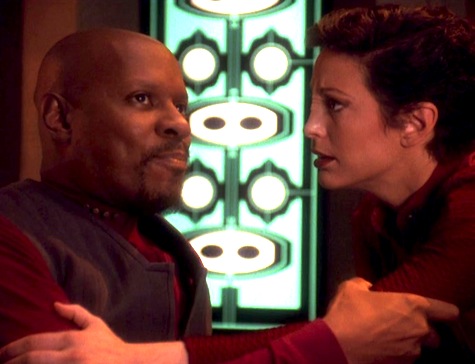
Well, almost never, but that’s the heart of the conflict. Sisko’s visions have given him a tremendous sense of clarity and a unique insight into the universe, and he doesn’t want to give it up—but his life is at stake, and he has to keep being reminded of that.
What’s particularly admirable about the episode is that it very quietly embraces cultural relativism without making a big deal about it. Winn is the orthodox hardliner, and she thinks that the Emissary must follow the path laid out ahead of him, regardless of the possible consequences to him or his family. Kira wants to respect Sisko’s wishes in much the same way Winn does, but she also has no problem deferring to Jake and respecting his decision to save Sisko’s life at the cost of the visions. Yates and Jake have no connection to Bajor or Bajoran religion, so they only see that someone they love is hurting and refuses to get help to fix it. (I especially like that Yates—who’s only just back after being in prison for six months—only urges Sisko to think of his son, not of her, since she’s not sure where she stands with him.)
But the episode is best encapsulated by the scene in Ops among Kira, Dax, O’Brien, and Worf. It’s honestly one of my favorite scenes in all Trek, because it embodies faith and self-determination and rationalism all at the same time. Dax and O’Brien are the ones whose lives revolve around science, and they prefer to let Sisko be treated by Bashir, while Kira and Worf understand the spiritual importance of what he’s going through.

(Speaking of Bashir, knowing what’s coming in “In Purgatory’s Shadow” and “By Inferno’s Light” really adds an interesting twist to the whole thing. How much of Bashir’s diagnosis was legitimate? Did he really treat Sisko, or did he contrive a way to make it worse so that his life would be in danger? Do the Founders have a vested interest in keeping Sisko from experiencing the full range of visions?)
Throughout all this are simply superb performances by everyone, particularly Avery Brooks. He’s been known to go way over the top more than once, but his obsession actually is tempered here. He also plays Sisko as not entirely there, as if he’s in two different worlds at once, and only occasionally pays attention to the one that isn’t visions from the Prophets. But we also see Sisko’s trademark enthusiasm for research and tinkering (last seen in depth in “Explorers”), now mixed in with prophetic visions.
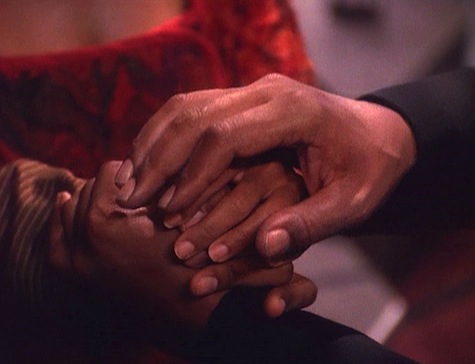
Honestly, almost everyone shines here, from Nana Visitor’s passionate faith tempered just enough by reason, to Penny Johnson’s constant reminders to Sisko of the world he actually lives in, to Cirroc Lofton’s anguish as he tries to understand why his father is letting himself basically die for some visions, and again when he has to make the decision to save his father’s life against his wishes. Best of all, though, is Louise Fletcher, who gives Winn some much needed nuance, as she tartly reminds Kira that she fought the Cardassians in her own way, and has the beatings and imprisonment to show for it. Plus she finds herself set adrift by the realization that her opposition to the Emissary has been completely misguided. (The “almost” is necessary, sadly, thanks to a very weak performance by Ernest Perry Jr. as Whatley, the only flaw in an otherwise excellent episode.)
Warp factor rating: 9
Keith R.A. DeCandido reminds everyone that The Klingon Art of War is on sale now! You can find the hardcover at your local bookstore or you can order it in hardcover or eBook form from Amazon, Barnes & Noble, Indie Bound, or direct from the publisher. Hear interviews with him about the book on the “Literary Treks” podcast from TrekFM, on TrekRadio, on The Chronic Rift, on The Sci-Fi Diner, on The G & T Show, and on Two Geeks Talking.










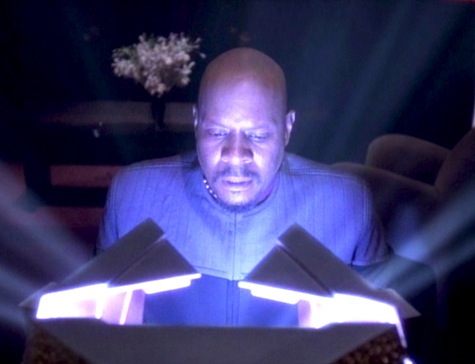
It was a great episode, even if only for the foreshadowing. Really great performances.
Just a great episode. I’ve also always loved the conversation in Ops about faith. It’s all too easy for a show, especially one rooted in science like Star Trek, to portray anyone at all religious or spiritual as some kind of backward primitive (see TNG’s “Who Watches the Watchers”), but they show it as a complex, nuanced thing, which I loved.
On the subject of Winn being there rather than Shakkar, I’ve occasionally wondered if perhaps the First Minister is only Bajor’s head of government, with the Kai as head of state. That would make a certain amount of sense for Bajor, a deeply religious society, and would explain the role Winn seemed to play. Granted, for something of this magnitude, it seems like they should both be there, but this explanation could at least mitigate that.
Since the series will teach us that Sisko is indeed receiving visions, this episode is a further step in DS9’s descent towards New Age mysticism and pseudo-religious mumbo-jumbo. I don’t see many ambiguities here.
I hardly can express how unsatisfying it is to see a Star Trek series validating obscure prophecies. In “Destiny” the writers were at least clever enough to point out that this stuff is always written in such a broad and vague way that it can be freely interpreted and made to fit almost anything.
Here we get swarms of locusts … ugh. I’d love a god or a superspecies with knowledge about the future just once to appear somewhere in broad daylight and hand the people an infopad with a clearly written message and preferably some proof about being a god or superspecies.
We’re just a step away from evil ghosts, magic books and the whole claptrap.
It must have taken a lot of work to get the higher level suits to approve this one. They had been leery of the whole religion angle right from the beginning and this has it in spades. It is reasonably well handled, though. I’m not sure I like it quite as well as KRAD did, but it is good. And they actually follow through on the prophecies rather than just forgetting about them.
I’m not entirely sure I buy the “lost city” thing. If they’d really been looking for millenia, they should have found something. There’s also the whole problem of time that plagues Bajor’s backstory. 10,000 years is roughly the length of time humans have been living in something resembling cities. The Bajorans really ought to be a lot further along technologically than they are. It just feels like various writers are tossing out big numbers to sound impressive without really thinking about. That or there is a serious flaw in the show bible.
I can’t really tell how I feel about the Easter egg of Sisko playing with his melon. Sure, it’s a nice nod and they didn’t go overboard anad have him say, “This means something.” But I’m not a big fan of Close Encounters, so meh I guess.
I wish I had something more intelligent to say (I feel like I should come up with some profound faith based thoughts, but I don’t have any at the moment – nice to see an episode about faith that doesn’t annoy me), so I’ll just say I enjoyed the episode and reading your review. And I also agree that Yates goes up in my estimation for recognizing the importance of Sisko and Jake’s relatiosnship.
I love these new uniforms as well so I’m excited when they show up.
Great episode.
Bobby
Overall, I enjoyed the episode, generally for the reasons given by krad. My quibble is with Yates. I don’t know if it was the character or the actor, but I found her overly demanding and hypocritical. I’m not positive, but wasn’t some of her justification for risking her life and freedom working with the Maquis to help relieve suffering? Here, isn’t Sisko risking his life to help an entire civilization?
I might even understand being pushy when he is totally out of it, but the continual guilt trips during the lucid periods was even worse. Sisko knows what he’s risking, what he might lose, and he believes the sacrifice is worth it.
I understand Jake and his youth, inexperience, and having-lost-his-father-once-and-mother-twice would be more reluctant to approve losing his Ben, but at least he showed internal conflict between his desires and those of his father.
I don’t think its hypocritical to have different views on what is acceptable risk for someone without children vs someone with a child (or children) Those are two different situations.
And my favorite ST uniform design finally makes it way onto my favorite series.
I LOVE the FC uniform style. The earlier TNG-era costumes, while military-esque, still seemed ridiculious when paired up next to the Romulan/Cardassian/Klingon uniforms.
There seems to be a photo-reference mixup: There’s a cover from Perchance to Dream next to the paragraph about Enterprises of Great Pitch and Moment.
I remember liking this episode, but I think that was in spite of the decision to turn Sisko into a full-on prophet (lower case) and religious visionary. I’ve said before that I didn’t like it how the series increasingly simplified the wormhole aliens from something very strange and alien and science-fictional to just a by-the-book religious pantheon. And while Sisko’s final full acceptance of his Emissary role is an important and effective step here, it sets up some unfortunate story decisions later on.
On the Bashir thing, I’m afraid the timing just doesn’t add up. The end of “By Inferno’s Light” says he’d been in captivity for four weeks, or “over a month” in O’Brien’s words (you’d think an engineer would be better at math). But in the next episode, “The Darkness and the Light,” Kira says she needs to carry the baby for at least three more weeks, and then she actually gives birth in “The Begotten,” making that presumably at least three weeks later. But “In Purgatory’s Shadow” says the baby is “less than a month old,” suggesting another interval of 3-4 weeks. And by my estimate, the 2-parter covers about a week of story time itself. And “Rapture” takes about four days, while TD&TL takes a similar length of time. So even if TD&TL begins the day after “Rapture” ends, we’re still talking a span of one and a half to two months between the start of “Rapture” and the end of “By Inferno’s Light.” Based on the stated timeline, Bashir’s abduction had to come between TD&TL and “The Begotten,” despite the uniform. The writers — or costumers — just plain got the chronology wrong.
@@.-@: “There’s also the whole problem of time that plagues Bajor’s backstory. 10,000 years is roughly the length of time humans have been living in something resembling cities. The Bajorans really ought to be a lot further along technologically than they are.”
There is no set or predictable pace of technological advancement. Different cultures on Earth have advanced at very different rates depending on their circumstances, needs, and values, and have had long intervals of stability between surges of progress. China was advanced enough to have an industrial revolution 700 years before Europe reached that point, but they had no economic or cultural incentive to do so — since the IR was driven by Europe’s craving for the wealth of China and East Asia, leading them to develop faster transportation and factories to produce competing goods. China already had all that wealth and power, so they had less incentive for change.
Or civilizations can advance in different ways that aren’t necessarily recognizable to each other. The European myth has long been that the Native Americans were technologically backward compared to Europe, but in fact they were more advanced than the early European settlers in a lot of ways — their longbows had better range and accuracy than the firearms of the day, the architectural techniques of peoples like the Inca were extraordinary, and of course the agricultural science of the New World was far beyond that of the Old World; something like 2/3 of the world’s staple crops today were domesticated or bred into existence by the Native Americans. So just because a civilization doesn’t advance along the same lines, that doesn’t make it objectively less advanced.
@9: The TNG costumes weren’t meant to be militaristic. Roddenberry at that point of his life was heavily downplaying the military side of Starfleet, preferring to see it as a peaceful exploratory/diplomatic service.
And personally I think the alien uniforms you cited were all pretty ridiculous. TNG’s Romulan costumes with those insane giant square shoulder pads were just hideous. And Cardassian and Klingon body armor doesn’t seem to be functional at all, since it never shields them from phaser or disruptor fire. Futuristic body armor should be something more flexible like Kevlar.
A truly magnificent episode. I agree with KRAD that the scene in ops is one of the best in Trek; it also shows why Worf was perhaps the best TNG character to be added to the show. I know I may be in the minority, but I enjoyed the turn to religious aspects in the show, and I thought this was excellently shown here.
A few points that people have addressed:
@2: I’ve also wondered about Kai Winn being the head of state, which would explain why she has to sign the treaty. On the other hand, the Federation probably would require some sort of separation of church and state, right?
@@.-@, @10: It does make sense that Bajor could be technologically slowed. The rigid caste system that existed up to the occupation probably didn’t help them advance as a society, but they also were advanced far beyond humans were in some respects (recall the solar spacecraft we saw previously).
@11 – I was going to bring up the lightship, I’m glad I’m not the only one who rememberd that. Wasn’t the ship (and the episode that introduced it) insprired by Kon-Tiki? Given that it was in use as early as what was called the 16th century on Earth, it makes Bajor one of the earliest space-faring civilizations. But even disregarding that, CLB has done his homework on different societies develop different technology.
I must admit that, while I do like this episode, there are a few things about the main plot that bug me. Nothing major, just little niggles. Shakaar not being present for the signing was one of them, also the pristine look of this 10,000 year old painting or that fact that apparently nobody had ever noticed the reflection on it before. Also, now that you’ve mentioned that Penny Johnson was only available for this episode that makes a lot of sense, because it does feel like she was inserted for no particularly good reason other than to make people say “oh, she’s back.”
But what raises this episode for me is actually Kai Winn. So often when she appears in the show your first thought is “I wonder what evil scheme she’s up to this time.” But if this was the only episode of DS9 you had ever seen, you would never know that she was one of the villains of the piece. And the result is that it makes her a much more 3 dimensional character than she has ever been before. All through the review I was wondering when you were going to get round to that speech she makes to Kira, because good as the scene in ops was, for me that was the moment of the episode, and Louise Fletcher sells it so well it pretty much gave me chills.
Ashcom@13 – Watching this episode makes me want to think, “Oh, maybe Kai Winn is not so bad (or is on the way to becoming)”, but then I remember all the commenters :)
@11: It’s ethnocentric to say a culture’s progress is “slowed” just because it doesn’t develop exactly like Western civilization on Earth. There is no universal standard, no “right” pace for a culture to develop. It’s not like the West is the default and every culture that has slower advancement is being retarded somehow. On the contrary, the normal pattern for most cultures in most of history is long stretches of stability and slow progress. The burst of rapid advancement in the West in the past couple of centuries is the anomaly.
The idea that societies even have to advance to be healthy is itself a modern Western bias. Many cultures have considered stability and tradition to be more important, and that’s not wrong, just different.
@12: Bajor one of the earliest spacefaring civilizations? Not even close. The Hirogen subspace network was built by unknown aliens 100,000 years ago. The Iconians thrived 200,000 years ago. Sargon’s people were colonizing the galaxy up to 600,000 years ago, and the Tkon Empire was already ancient at that time. Voth civilization is at least 20 million years old. The D’Arsay from TNG: “Masks” launched their archive 87 million years ago. The insectoid aliens from TAS: “Beyond the Farthest Star” lived 300 mya. The First Humanoids from “The Chase” lived 4 billion years ago. It’s an old, old galaxy.
Given the timeline issues that CLB brings up and the disturbing thought of krad that it was Changeling Bashir operating on Sisko’s brain, I wonder at what point in the series did the writers decide that Bashir would be kidnapped and replaced by the Dominion? In other words, did the writers know this would happen when they wrote Rapture? I know the uniform change made it easy on screen to show which Bashir was which, but maybe they got too clever there.
On the “Did Changling-Bashir interfere with Sisko’s visions,” I stopped watching early sixth season, so I don’t know whether or not this point was ever addressed: what did the Founders know about the wormhole aliens? Had they run across these creatures or something like them before, or were they as much a mystery to the Founders as they were to the DS9 crew? Because if the Founders knew something about the Prophets and their abilities with time, I would expect Changling-Bashir to try to interfere, but if not, I’d expect him to just let it play out. The Changlings always struck me as atheist and even more inclined to dismiss the Bajoran religion as “superstitious mumbo-jumbo” than Dax and O’Brien.
@11,
I see no reason why the Federation charter would require separation of church and state. They seem to give their members quite a lot of latitude in how they run internal affairs. There might be some proviso to insure the rights of those not part of the State Religion, but I doubt that merely the existance of an official church as part of the government would be a disqualification for Federation membership.
@3 In the case of the Bajoran prophecies, I’m okay with them being a little cryptic if you think of it in terms of something like, the Prophets speak in ways so alien that your brain has to interpret them in ways you’re already familiar with. So the Bajoran who had the vision 5,000 years ago might have interpreted the Dominion ships as locusts.
Kind of a stretch sometimes, I’ll admit. And I, too, wasn’t entirely satisfied with the way the Prophets were handled as the series went on. But I’ll give the show some leeway on this particular point.
-Andy
Lemaitre: The thing is, the visions Sisko experiences are all consistent with previous experiences with the wormhole aliens: all interactions with them are metaphorical because they’re not corporeal, and they can see the past, present, and future with equal clarity because they don’t exist in linear time. That tracks with Sisko’s visions, which ran the gamut from past to present to future.
RaySea: The notion of Winn as head of state makes no sense when you consider that Winn ran for first minister in “Shakaar.” That episode made it clear that the position of kai was one of spiritual importance and often of political importance, but has no direct governmental role.
DemetriosX: As Christopher has already eloquently pointed out, technological development doesn’t work the way you think it does. I’ll also add to his point that it doesn’t always go in a straight line, either. The people who lived in what we consider now to be Europe lived a much more technologically advanced life under the Roman Empire than they did 500 years later under the various nation states (including history’s great misnomer, the Holy Roman Empire, which was none of those three things). Also the Cardassian Occupation would have had a very obvious adverse effect on Bajor’s technological development…..
Christopher: in defense of Chris Lough, who chose the pictures, that issue of Perchance to Dream also has the title “Enterprises of Great Pitch and Moment,” because I did the same gag with PTD that I did with Slings and Arrows, to wit, using Hamlet’s “To be or not to be” speech for the titles.
—Keith R.A. DeCandido
Personally, I give this a 10+. Whatley isn’t bothersome enough to bring down my enjoyment of this one.
Rapture not only works as a major plot-centric episode, moving major arcs in the Trek universe, but it also works as one of the best character pieces ever. This serves as a sequel to Emissary, Accession, For the Cause and especially The Visitor. It’s also the inevitable prelude to the Purgatory/Inferno two parter and the upcoming war.
It took over an year for Ira and the writers to reach this point. Not only they meant to do the Paradise Lost two parter as a cliffhanger, but also meant to advance the Bajor/Dominion plot points a lot sooner, but they got sidetracked with the whole Klingon diversion. I don’t know how much of this was planned in advance, but for all purposes Rapture should have been a mid season 4 episode.
Needless to say, this is one of my all-time favorite Trek episodes. Brilliantly produced on every level, especially the performances. You could never do this episode on any prior Trek series. Even TNG’s Who Watches the Watchers, which dealt with Picard as a deity, only tackled the subject on a superficial level. DS9, through its long-term commitment to these characters, had no other choice but to address how Sisko’s path as an Emissary would affect his family, AKA Jake and Kasidy. And Beimler does a beautiful job of marrying such an intimate personal story with the political ramfications for both Bajor and the Federation.
This is a superb follow-up to Accession, doing a brilliant job of tracking Sisko’s emotional path, as he embraces the very thing he wanted nothing to do with in the first place. But to also include Winn as part of the conflict is nothing short of brilliant. Louise raises the character to another level, adding layer upon layer.
I often wonder what would have happened, had the writers reaffirmed Bajor’s approach to the Federation. Personally, I would decide it was for the best for them to not join the Feds, but remain allies and an independent part of the quadrant. Given the casualties of the Dominion War, plus the Maquis resentment, and the ultimate demise of the Cardassians, there’s really no need for Bajor to be a part of the Federation. They already enjoy a solid relationship. When we see a moment such as Kira giving Jake the right to make the choice for his father’s fate, the membership doesn’t seem all that meaningful. It’s only a piece of paper with a signature.
Also, there’s something about Dax’s skepticism on the Prophets that always made me wonder: she had previous hosts. Were all of them pure believers of science, or could one or another host have some room for spirituality? And if so, wouldn’t that affect the symbiont in the long run, and by extension, Jadzia (and later Ezri)?
Even despite some of the misteps the writers would take with the Prophets/Pah-Wraiths in the last two seasons, I can’t help but feel that Rapture brilliantly sets up DS9’s very final scene, with Jake (standing alongside Nerys, BTW) having to let go of his father, as he finds his place amongst the Prophets.
@14, Yeah, I like the ambiguity with Winn we saw here and later in Season 5 when she and Sisko had to reluctantly join forces and found common ground against the Dominion threat.
After spending 4 years despising and distrusting Sisko, I liked her uncertainty about the future in the wake of Sisko finding the lost city.
@10, Regarding the unfiforms, yeah, the Romulan redesigns sucked for TNG. I’ll agree with that.
I think I liked the FC unfiforms as they were kinda a callback to the more practical TWOK-era uniforms.
Is it possible that the Bashir captured/imposter issue happened because the script for “In Purgatory’s Shadow” wasn’t completed yet, therefore the writers of the earlier episodes were never made aware that Bashir had been captured and replaced, and therefore should make sure he didn’t do anything amazingly medical, or was it just that the implications of his capture were never quite realized? It could have been an interesting tidbit if Sisko needed the surgery but Bashir had deferred saying Dr. So and So on board the USS Whatever had better facilities/experience whatever. Ten when Purgatory’s Shadow happened, we would have had an A-HA moment when we realize why Bashir was deferring procedures. The alternative is that not only do the Changelings have a way to impersonate people but access their memories, which actually makes sense. If Starfleet doctors can supress memory, why shouldn’t the Founders be able to download them?
As far as the uniforms go, while the Klingon armor makes sense in some sort of traditional view, I agree that just about everyone else’s uniforms make no sense. While I don’t expect other races to have North American fashion sense, the Romulan squared-shoulder uniforms and Cardassian armor don’t seem to be that functional. They serve as distinctive, but not functional pieces. Also, the Starfleet uniforms make zero sense, especially for Security and Marine types. Some sort of ablative/phaser resistant material would make sense, or even better a personal shield generator. If Worf can turn his combadge into a personal shield in a holodeck, why shouldn’t combat personnel have something similar. I get that it makes no sense for most personnel as they are in either office or starship settings where on most days you don’t need to fight off a phaser wielding enemy, but there is a minority where it does make sense.
Also, where exactly do Starfleet people hold onto things? They have those fun Batman-esque utility belts for their phaser, flashlight and tricorder, but where do they keep their PADDs and other equipment? Its not as if you would want to keep everything in a cloud environment where you can grab the nearest PADD, it identifies you and pulls up all your work/files/etc. because you’d want to be able to utilize it in case of main computer failure, off ship, whatever.
@15 – Touché. I tend to forget about the ancient species since we don’t really see that much of them. Of course, I also disliked The Chase (other than Gul Ocett) enough that I generally pretend it didn’t happen. I much prefer non-explanations that tacitly acknowledge the fourth wall over attempts to justify production constraints in-universe, but that’s a matter of taste, not canon. As it is you are indeed correct, as I would expect from someone in your line of work.
(Moderator note: deleted the duplicate post. Thanks!)
@22
Is it possible that the Bashir captured/imposter issue happened because the script for “In Purgatory’s Shadow” wasn’t completed yet, therefore the writers of the earlier episodes were never made aware that Bashir had been captured and replaced, and therefore should make sure he didn’t do anything amazingly medical, or was it just that the implications of his capture were never quite realized?
The way I see it, definitely choice number 2. They weren’t quite realized (although the writers would make up for this on both Dr. Bashir I presume and Inquisition).
Although Ira Behr and Robert Wolfe were pushing the envelope in terms of serialized storytelling on Star Trek, they were still newbies to this process, like every other writer on staff, and therefore could still make mistakes.
@21: I’m sorry, the TWOK uniforms were “practical?” How? They’re basically Horatio Hornblower cosplay, ridiculously overelaborate attire based on Nicholas Meyer’s preference for history over futurism. They’re overcomplicated and look very heavy and uncomfortable. I could buy them as formal dress uniforms, but as everyday fatigues they’re insane. Ditch the double-breasted jackets, use the turtleneck underneath as an everyday tunic (like in the original pilots), and then you’d have something marginally sensible. But as it was, no way.
Now, the ST:TMP uniforms were practical. They came in a wide variety of variants — one-piece, two-piece, long-sleeved, short-sleeved, and so on, plus specialized attire like body armor for security personnel and radiation suits for engineers. They looked like plausible everyday duty wear for spaceship personnel in the future. The TWOK uniforms looked like costumes in a movie.
@24: Well, attempts to justify the preponderance of humanoid aliens in Trek go back to the original series, which tried it twice: “Return to Tomorrow” established that Sargon’s people had founded colonies all over the galaxy and hinted that they might potentially be the Vulcans’ ancestors (although it was specifically stated that the evidence showed that humans evolved on Earth), and “The Paradise Syndrome” introduced the Preservers as an attempt to explain the various Earth-duplicate cultures TOS often used to save money (although it doesn’t really work as an explanation for most of them).
Now, the ST:TMP uniforms were practical. They came in a wide variety of variants — one-piece, two-piece, long-sleeved, short-sleeved, and so on, plus specialized attire like body armor for security personnel and radiation suits for engineers. They looked like plausible everyday duty wear for spaceship personnel in the future. The TWOK uniforms looked like costumes in a movie.
@25
Thank you! I thought I was the only one who had that viewpoint (I tend to hold back from STII criticism, mostly because of other fans).
You have to separate practical from good-looking. The red uniforms they wore in Khan might’ve looked good on the screen, but Meyer was essentially taking a leave of creative license, and away from a truly accurate depiction of Starfleet’s wardrobe.
Still, I recall Shatner’s complaints about the original film’s uniforms being very uncomfortable to wear. At least, he made the story entertaining for the readers of Star Trek Movie Memories. Part of the redesign, the way I see it, was a way to please the movie’s star.
@27: I don’t think the TWOK costumes are all that good-looking. Maybe I’d like them better if the jackets were navy blue instead of that unappealing red-brown shade.
@CLB You’re absolutely correct that there’s no natural pace of development; I only meant to make the point that the caste system on Bajor would have restricted potential for development, much as I would argue it did in India, and much the same as say, the feudal system, held back development in Western Europe.
The First Contact uniforms are my favorite Trek style of uniforms, along with the Enteprise NASA inspired coveralls. The TWOK style looked good as formal dress, but they weren’t practical. TMP and most of the TNG uniforms looked too much like pajamas.
Which brings to mind one of the most ridiculous comments in TNG: Picard calling Q’s US Marine uniform a “costume” while wearing his red and black PJs. Think you got that backwards, Johnny boy.
@30: The First Contact uniforms are my favorite Trek style of uniforms.
Except they aren’t uniforms, they’re mechanic’s overalls. You can’t even tell rank or branch from a distance.
The franchise hasn’t had anything resembling a duty uniform since the pre-TNG movies (there have been things that can pass for good formal uniforms though), just people in jumpsuits and overalls that get progressively darker with time…because dark is edgy and cool and stuff.
Also, it also helps that the newer designs pad more and help conceal beer guts and sagging breasts. In the only Star Trek whose title is true you actually *had* to have a physique that could fit a uniform; now any slob can just cover himself in layers of dark wool and pretend to play space soldier.
#31
Try to add a little more fiber to your diet. Helps improve bad moods.
Yeah, heaven forbid those slobs with sagging breasts think they belong in Starfleet… *rolls eyes*
Quoth Redlander: “Which brings to mind one of the most ridiculous comments in TNG: Picard calling Q’s US Marine uniform a “costume” while wearing his red and black PJs. Think you got that backwards, Johnny boy.”
Actually, that was a very smartly written line, because from “Johnny boy’s” perspective, what Q was wearing was a costume. Most people now would refer to a military uniform from 400 years ago as a costume as well.
—Keith R.A. DeCandido
@34: In a broader sense, everything Q wore — including his humanoid form — was a costume. The guy was basically a cosplay fanatic.
Picturing Bashir in this and the next few episodes as a deep-cover changeling *really* doesn’t jive in my head. I think in my mind, this will always be the real Bashir, who some time in the near future is going to wear his slightly out-of-date uniform for some reason (laundry day?) while he heads off to a conference where he’ll be kidnapped.
Also, one quibble more related to the main plot. Speaking as a Mormon physicist, I think it’s unfortunate that this episode perpetuates the stereotype of science and religion being incompatible within a person’s belief. Did O’Brien and Dax BOTH have to be skeptical of Sisko’s experience? With no other scientifically-minded character to provide a foil for them? Even a minor Bajoran engineer or something who was inclined toward both science and religion would be appreciated. (It’s not like I’m in a unique situation here — a large fraction of Earth’s great scientists have also been quite devout. In fact, I’m not sure the science “versus” religion thing even became a stereotype until Paul Dirac’s scathing comments against religion became widely publicized in the 1920s.)
I remember being a little disappointed, not with the episode in and of itself, but with the fact that the ambiguity of the wormhole aliens and Sisko being the Emissary would be simplified going forward. They were going with Sisko full-on as a religious figure, and fully embracing it, and, to me at least, that took away the mystique surrounding the wormhole aliens.
The episode itself is quite good, my favorite parts being how Jake and Kasidy dealt with the situation. Its easy to go on and on about prophecies and the meaning of life and all the rest of it, but what about the people who love and depend on you? Aren’t they important too? I was glad to see the episode address this point.
And I agree CLB about the TWOK uniforms. As great as that movie is, I remember being disappointed that they abandoned the comfortable-looking uniform styles of the previous movie. Those red suits looked really warm, and Nichelle Nichols said in her autobiography they were so uncomfortable. Honestly, I didn’t like the First Contact-style uniforms at first, but I warmed up to them.
McKay B@36 – I sympathize with you too :) But, this episode didn’t actually irritate me on that front, although maybe I am just inured to it.
This episode irritates me a lot, actually. Mostly because it purports to be an allegory about religion but it’s really not. It insists on treating Sisko’s religious visions through the lens of atheistic skepticism, which is just fundamentally stupid. Because, yes, the Bajoran religion is experienced as a religion by them. But Star Fleet knows full well that it’s not just a religion. Because they’ve met the wormhole aliens.
There is still room in that to do most of what they wanted to do here. There’s the issue of self-sacrifice, of gaining a perspective on the universe that massively exceeds what humans normally have, and the element of faith that goes into trusting beings that exist on that different plane. But those are questions about capacity to understand, motive, etc. Not questions about the basic existence of the ‘gods.’ They’re not mystical illusions; they’re advanced aliens.
The real tension of the episode needed to be questions from everyone else about whether these visions he’s having are in fact real, if he is channeling the wormhole aliens, if it’s worth doing it, and so forth.
For a Federation that has consistently interacted with Q, why is it so hard for them to believe that the Wormhole Aliens are, you know, real?
It’s funny that Sisko’s visions of the future come from an electric shock in the Holosuite. But if Sisko had the shock Lister received in the Red Dwarf episode Queeg, the blast probably would have sent him into the future as well. Worf’s Klingon proverb “You cannot loosen a man’s tongue with root beer” is right up there with Spock’s ancient Vulcan proverb “Only Nixon can go to China”. I don’t like the way Whatley said “We’d probably lose Bajor forever” as if the planet were a prize to the Federation. And DS9 does like to mislead us with its bad guys seemingly getting better, like with Kai Winn here or Gul Dukat right up until By Inferno’s Light before kicking us in the teeth for thinking that. The only one who really completes they’re redemption is Damar in What You Leave Behind.
The problem I have with this episode is what it implies about the worm hole aliens. From the early episodes it seemed as though the aliens had only limited contact with the “linear” species. They seemed to have a difficult time comprehending how the Bajorans and Humans experience the flow of time. So how could they give Sisco or any other “prophet” visions of the future? They have no reference point to understand where in the time line the vision seeker is relative to the vision of the future that they are given. In my opinion these aliens are unworthy of being worshipped. If they are aware that the Bajorans worship them as gods, then they are unwilling to come out and say “we are not gods, we are a life form from another plane of existance”. Even Q wouldn’t allow an inferior species to worship him for longer than the amount of time it takes for him to get bored. Or the aliens are not aware that they are being worshipped. In that case they are too far out of touch with corporeal life for their visions and prophecies to have any relevance. The writers should have stuck with the original premise from the early seasons; namely that the worm hole aliens are simply just another species that we don’t quite understand, and that the Bajorans were misguided about treating them as gods. Obviously the Bajorans civilization had reached a decent level of advancement and presumably had fallen behind before they were occupied by the Cardassians. The reason for this could only be the rigid caste system that was based on the worship of the aliens. The aliens did nothing to guide Bajorans away from this destructive and demeaning path, So there is another reason the aliens do not deserve to be worshipped. In fact the deference that Starfleet pays to this religion would have Roddenberry spinning in his grave. In his vision of the future Starfleet would pat Bajorans on the head and say “isn’t that cute” regarding the alien religion. It’s past the time when Starfleet should have sent multiple ambassadors into the worm hole to open diplomatic relations with the aliens and attempt to find out if they have an agenda, and what that agenda might be.
Too much prophets, religion, visions and more religion for me. Also, is it just me or isn’t Sisko not very well versed in the Bible? How can he have a vision of Locust without at least ONCE acknowleding the 10 plagues? If I’m not mistaken, it was the 8th plague in Egypt.
Also, the new uniforms look ugly. :(
@42/waka: Why would Sisko be well-versed in the Bible? He lives in a secular society. And locusts aren’t something the Bible made up; they’re real insects known for swarming en masse and destroying crops. They’re mentioned in many works of ancient literature, including The Iliad. The Bible has no exclusive claim to the metaphor.
Geez, this episode was horrible…it’s probably the first time when i totally disagree with the rating of the rewatch…visions, mine, city, no reasonable story, just SUDDENLY an almost signed Federation treaty which totally came out of the blue and the 10 minutes to find a city we’ve never heard about before…
43. ChristopherLBennett: I am sorry about the very late reply. The question is, why WOULDN’T he know about the 10 plagues? Even I know about them, and I stated more than once that I am not even interested in religion. And the image of the Locust swarming over the planet just has such a strong resemblance to the 10 plagues that it really surprised me Sisko wouldn’t mention any of it.
@45/waka: Like I said, locust plagues have been a real thing throughout history and the Bible has no exclusive claim to the concept. You might as well ask why someone saw a tornado and didn’t reference The Wizard of Oz. It’s too widespread, too generic a phenomenon to expect it to be uniquely associated with a single literary work. “Swarm of locusts” exists as a metaphor in its own right far beyond the Bible, so it makes no sense to be surprised that someone referenced one without the other.
The phrase “Biblical swarm of locusts” has over 5,000 hits on google. And Sisko is a religious figure for the bajorans. Plus, this episode is called “Rapture” So, to think about a biblical reference when seing a swarm of locusts isn’t really that far fetched.
@47/waka: No, it’s not far-fetched, but mentioning locusts without mentioning the Bible is not remotely far-fetched either. There’s no reason they can’t both happen in different cases, so there’s no reason to be surprised by either one.
Winn could have been a much more complex character if she’d gotten more screen time. Even with her ultimate destiny by the end of the series, I feel a little sorry for her.
As much as she loves power and control and has been corrupted by it, this episode shows she’s also a product of the Occupation. Her faith was what kept her going throughout and she suffered for it. It the meantime, as she reveals in another episode, she was learning to practice politics and cut deals with the right people to save what Bajorans she could. Then the Occupation was over and the Cardassians were gone. In one of the final episodes, Winn talks about how she came to the station after that and saw the “Celestial Temple” open for the first time. She expected to be swept away emotionally just like everyone else. Instead she felt nothing.
From a real-world perspective, she could easily have been suffering from exhaustion or even PTSD as many other Bajorans would have been. From her perspective, her faith had failed her at a critical moment; it’s easy to confuse emotion with belief and faith. There would have been nobody to tell her that, though.
So she continued on doing what she still knew, scheming and accumulating influence and telling herself that it was all for the good of Bajor and in the service of the Prophets. She probably wouldn’t even admit to herself how much that power and influence helped to insulate her from the memories of the Occupation that still haunted her.
Lockdown Rewatch. Well the Bashir Changeling is certainly playing a long game isn’t he? He could have despatched one of the Dominion’s biggest adversaries here in Sisko, but instead he not only saves Sisko’s life he performs extremely complex Brain surgery to do so. They really dropped the ball there with the uniform when the Changeling is revealed in a few episodes time, they didn’t think it through and if they had kept real Bashir in the new uniform it could have been explained the switch happened after this episode. I think this is a solid episode but I wouldn’t go as far as giving such a high score as a nine a bit too much mysticism for my liking. Louise Fletcher is much better at this point as Winn now she has turned the boo hiss villain performance down a few notches.. unfortunately by the end of the series she will turn it back up to eleven. I would rate this episode a 7 out of 10.
Waka,
Christopher is quite correct. I’m a fairly conservative Roman Catholic. The Bible is quite important to me and the Biblical plagues of Egypt of interest to me. (as a costumer/cosplayer my wife and I coordinated a group that did a costume presentation of the Plagues.)
However, locusts are everywhere. Swarms of them have been destructive for millenia and all over the world. Native Americans, Eastern Asia, literally anywhere on Earth would be familiar with the metaphor of a swarm or horde of locusts without any familiarity, or knowledge, of the Bible.
While I like this episode, I think it and every episode where the “Prophets” are a plot or character point are always undercut by the fact that Sisko and maybe anyone (Zek) can drop in on the Wormhole Aliens whenever the writers feel like it. Accession is one of the worst reminders of this and it’s not out of the realm of possibility to see an ending where Jake loads his dying dad in a runabout and drops in to ask the Prophets just what the heck they are doing. To that end, I question the concept of “Faith” discussed in the show and here. Religious faith, generally, requires doubt – doubt about whether your god exists or not. This faith is the act of believing in something that you will never be certain is real, and yet you choose to continue your belief. Sisko does not need faith when it comes to the Prophets since he’s hung out with them extensively. He may need to have faith that his visions are coming from the Prophets and that he’s interpreting them correctly – but this is just an extreme level of having faith that the mailman will bring the mail: he may or he may not, but you have no doubt that the mailman exists. I don’t think it’s fatal for the show, but it does make it very odd if you scratch the surface.
As this is my first watch, I don’t know the answer here: do more Bajorans get to meet the Prophets? It again makes Accession weird: Laan is suddenly in the presence of his gods and he doesn’t react much at all – he’s way chill in a way I have trouble seeing Kira be. But it begs the question: why aren’t Winn and a bunch of other Bajorans trying to get in direct touch with their gods
@52/kalyarn: It’s not so much about having faith that the Prophets exist or that they can see the future. It’s about whether the Bajorans are right about the Prophets’ relationship to the Bajoran people. Are they just extratemporal aliens with a profoundly alien worldview, unconcerned with matters in our continuum except when they impinge directly upon the wormhole, and just happening to send out Orbs that the Bajorans unilaterally project spiritual meaning onto? Or are they truly connected to Bajor, invested in the well-being of its people and actively guiding them over the millennia?
More to the point, this episode is about Sisko’s faith in his own personal relationship to the Prophets. Is he just a Starfleet captain relating to a species of aliens? Or does he truly embrace his role as the Emissary, to the point that he’ll endanger his own life to get out their message? A large part of religious faith is renunciation, the willingness to subsume personal needs to serve one’s spiritual duties — to renounce worldly goods and relationships, to undertake fasting or mortification, even in the extreme to sacrifice one’s life. It’s not about faith in the mere existence of the divine, it’s about faith that the will of the divine is benevolent even when it demands your own self-abnegation or sacrifice.
“But it begs the question: why aren’t Winn and a bunch of other Bajorans trying to get in direct touch with their gods”
They already do that, through the Orbs.
Does anyone else think that Bashir’s nurse resembles Ezri Dax and if Quark had been zapped in the Holosuite instead of Sisko, would he have received visions of Bajor’s future?
David Sim: Not even a little bit, and Quark wouldn’t have been zapped ’cause he ain’t the Emissary.
—Keith R.A. DeCandido
Ah, the episode where Sisko goes full on Colonel Kurtz. This episode only adds fuel to my belief that Sisko is S31 himself, otherwise Starfleet would have fired his ass over this. Starfleet officer posing as a religious figure, it was bad enough when he was just being far too passively accepting the Bajorans worshipping him, but to go so far as to actively insert himself into their mythology like this is completely beyond the pale. He might be a fascinating character, but Sisko is the worst Trek captain of all, including the lunatics from Discovery and Lower Decks and the weenie from the start Of Generations.
55: I don’t know, Krad. She has roughly the same hairdo and they’re about the same height. And I do like the idea of Quark getting the visions that were supposed to be meant for Sisko. He’d be charging Bajorans en masse to learn about Bajor’s future with Kai Winn paying him under the table.
I don’t think you’re posing as a religious figure when you actually are one.
Avery Brooks’ performance is wonderful in this episode, except toward the end (much like in “Far Beyond the Stars”) when he wakes up from surgery and realizes his clairvoyant abilities are gone. Through Brooks’ histrionic line delivery and facial expressions, I can’t buy his anguish at all.
@58,
Heh.
“So, what do you think [Chief O’Brien]? Am I Buddha, or am I Jesus?”
(The joke is at 10:00).
@59. That’s been an issue for me and many others as far as Brooks’ acting choices. He’s prone to weird facial expressions, goofy broad smiles apropos of nothing, and don’t even get me started on when he tries to look all tough and menacing. I just never been a fan, and as much as I enjoyed the complexity and depth of DS9, it was hard to get through it with him portraying the lead character.
This is my first time watching through DS9 so perhaps I missed something along the way, but WHAT is Yates doing back? Isn’t she the one who was lying to Sisko so that she could continue smuggling stuff to the Maquis, the people he was supposed to be tracking down? At the very least, however lovey-dovey they were, Sisko has got to wonder whether the whole relationship was based on manipulation so that she could get intel to help with her smuggling if not to help the Maquis themselves. And yet she waltzes back in after serving her sentence as if she’d been away on a navigation course or something. Sisko should be a lot more wary about letting her back into his life.
@62/rwmg: This was addressed at the end of “For the Cause.” If their relationship had just been a lie, then Kasidy would’ve fled with the rest of her crew and Sisko would never have seen her again. But she voluntarily came back to the station at the end of that episode, even knowing that she’d be arrested, because her love for Sisko was real and she valued it above her own freedom.
The dialogue at the end of this one makes me upset that Bajor apparently hasn’t joined the Federation by the time of Lower Decks. Surely, the word of the Emissary outweighs the word of the showrunner.